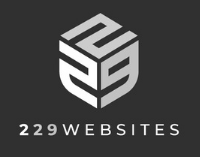Essential Elements of a Successful Website
Design, Functionality, and User Experience

Websites in the digital era are like your modern storefronts; they're the first point of interaction between your brand and potential customers. Whether you have a law firm website, gym website, restaurant website, or other types of small business websites, the critical trio of a successful website includes design, functionality, and user experience - these factors shape how people perceive and engage with your brand online. If you’ve ever wondered why some websites soar high on search engines while others crash and burn, or why certain sites have visitors that stick around while others face heavy bounce rates, this blog post will unveil those secrets. Dive deep into the art and science of optimizing design, enhancing functionality and delivering seamless user experiences as we unveil the essential elements of a successful website! No matter whether you’re a rookie start-up or an established organization seeking digital refinement, achieving online success begins here.
The essential elements of a successful website include easy navigation, an appealing visual design, well-written content, compatibility with all major browsers and search engines, interaction with visitors, intuitive layout and accessibility. Additionally, effective websites prioritize branding and have fast turnaround times while focusing on generating conversions by providing tools for potential clients to conduct business easily.
User Experience and Interaction
When it comes to designing a successful website, one of the most critical elements to consider is user experience (UX) and interaction. A website that prioritizes UX ensures that visitors have a seamless and enjoyable experience while navigating through its pages. It goes beyond just aesthetics—it encompasses how users feel, think, and interact with the website's interface.So when you plan on having your first law firm website, gym website, restaurant website, or a different type of small business website, make sure to keep use experience in mind.
To create a positive user experience, designers should focus on several key aspects. First, attention should be given to the visual design of the website. Utilizing appealing graphics and illustrations can impress visitors and make the website appear trustworthy and professional. However, it's crucial to strike a balance and avoid excessive use of animations or scrolling text that may distract or overwhelm users.
Imagine visiting a website that bombards you with flashing banners, blinking buttons, and autoplaying videos as soon as you land on the page. The frustration and annoyance it brings can quickly push visitors away.
In addition to visual appeal, functionality plays a significant role in providing an excellent user experience. The website should be responsive across different devices and screen sizes, ensuring that users can access its content seamlessly whether they are on their desktop computers or mobile devices. Fast loading times are essential too since slow websites can be frustrating and lead to high bounce rates.
Interaction is another crucial aspect of user experience. Effective websites engage visitors immediately and hold their attention throughout each page. Interactive elements like intuitive contact forms, polls, or quizzes can encourage visitor participation and increase engagement. However, it's important to strike a balance between interactivity and intrusiveness—being overly intrusive with pop-ups or notifications can annoy users instead of engaging them.
Now that we understand the importance of user experience and interaction let's dive into another crucial element of a successful website: Navigational Structure and Ease of Use.
Navigational Structure and Ease of Use
A great website should have an intuitive and user-friendly navigational structure. It should allow visitors to easily find their desired information or complete specific tasks without feeling lost or confused. Navigational menus and clear links are essential for guiding users through different sections of the website.
To ensure ease of use, designers should organize the website's content into logical categories and subcategories. This way, visitors can quickly locate the information they need, reducing the time spent searching and increasing overall satisfaction. Utilizing drop-down menus or breadcrumbs can provide additional navigation aids and enhance the user experience.
The placement of key information is also crucial for accessibility. Visitors who may not have the time to explore the entire site should be able to find important details such as contact information or specific product/service information easily. Frustrating or difficult experiences can discourage visitors from staying or returning to the website.
Imagine needing urgent medical assistance and visiting a healthcare provider's website that buries their contact information deep within multiple pages. The frustration caused by struggling to find a simple phone number can deter potential patients from seeking their services.
Anticipating visitor needs is another essential aspect of navigational structure and ease of use. By understanding the common goals and intentions of visitors, designers can create landing pages that directly address those needs. For instance, an online store might have different landing pages for different product categories, making it easier for customers to navigate directly to what they are looking for.
Now that we've covered the importance of navigational structure and ease of use let's explore more elements that contribute to a successful website in our following sections.
Anticipating Visitor Needs
A successful website goes beyond simply providing information; it should anticipate the needs of its visitors. By understanding who your target audience is and what they are looking for, you can design your website to meet their expectations and provide a seamless user experience.
Put yourself in the shoes of your visitors and think about what they would want to see and how they would navigate through your website. Consider the purpose of their visit and what actions they are likely to take. For example, if you run an e-commerce website, visitors may want to browse products, compare prices, and make a purchase.
To anticipate these needs, ensure that your website has clear navigation menus that are intuitive and easy to understand. Organize your content in a logical manner so that visitors can quickly find what they are looking for. Use headings, subheadings, and bullet points to break up lengthy text and make it more scannable.
Let's say you have a fashion blog. Visitors may be coming to your site looking for outfit ideas or advice on the latest trends. In this case, you could create a "Shop the Look" section where visitors can easily find and purchase the items featured in your blog posts. By anticipating this need, you not only provide value to your visitors but also potentially monetize your website through affiliate marketing or sponsored collaborations.
Anticipating visitor needs is not just about navigation and content placement; it also involves optimizing the performance of your website to provide a smooth user experience.
- According to a research study by NN Group, users spend an average of 5.59 seconds looking at a website’s written content suggesting that websites with clear and concise messages can better engage users.
- In a recent survey by Adobe, 38% of people stated that they will stop engaging with a website if the content/layout is unattractive in its imagery or color schemes.
- Research from Stanford University suggests that 75% of web users make judgments about business' credibility based on their website design indicating the high importance of visual design on a website's success.
Content Strategy and Goal Orientation
Content plays a crucial role in attracting visitors to your website and keeping them engaged. A well-thought-out content strategy ensures that the information you provide is valuable, relevant, and aligned with the goals of your website.
Consider who your target audience is and what they are looking for when creating content. Conduct market research and analyze competitor websites to gain insights into what topics are popular and what gaps you can fill. By addressing the specific needs and interests of your audience, you can position yourself as an authority in your niche.
Some argue that it's important to prioritize search engine optimization (SEO) when creating content, while others believe that focusing on user experience is more important. In reality, both aspects are crucial for the success of your website. Balancing SEO best practices with engaging and informative content ensures that your website ranks well in search engine results while also providing value to your visitors.
Once you have a clear understanding of your audience and their needs, align your content strategy with the goals of your website. What actions do you want your visitors to take? Are you aiming to drive sales, generate leads, or increase brand awareness? Every piece of content should serve a purpose and lead visitors towards achieving those goals.
Let's say you run a fitness blog and one of your goals is to increase newsletter sign-ups. Your content strategy could include creating informative articles about nutrition and workouts but also offering a free e-book or exclusive workout plans as incentives for signing up for your newsletter.
Crafting relevant information for your audience is essential, but equally important is ensuring that the layout and design of your website support the readability and digestibility of the content.
A carefully planned content strategy is important for the success of your website. Understanding your target audience, conducting market research, and aligning your content with the goals of your website are crucial steps in creating valuable and engaging content. Balancing SEO best practices with user experience is also necessary to ensure that your website ranks well in search engines while providing value to visitors. Additionally, it's important to craft a layout and design that supports the readability and digestibility of your content.
Crafting Relevant Information for Your Audience
When it comes to designing a successful website, crafting relevant information for your audience is crucial. Gone are the days when visitors were patient enough to explore every nook and cranny of a website to find what they're looking for. Today, users have shorter attention spans, and you need to grab their attention immediately with concise and engaging content.
Start by identifying your target audience and understanding their needs, preferences, and pain points. Conduct thorough research and create detailed buyer personas to guide your content creation process. This will help you tailor your message specifically to your audience's interests, making them more likely to engage with your website.
For instance, if you run a fitness blog targeting young adults interested in HIIT workouts, you'll want to provide relevant information such as exercise tips, diet plans, and success stories from individuals who have achieved their fitness goals using your methods. By understanding your audience's needs for effective communication, you can establish yourself as a trusted resource.
Once you have a clear understanding of your audience, focus on creating compelling headlines and subheadings that capture their attention and communicate the value they will receive from reading further. Use clear and concise language that is easy for readers to understand, avoiding jargon or unnecessary technical terms.
Structure your content in a logical manner, using headings, subheadings, bullet points, and numbered lists to break up text and make it scannable. Incorporate visuals such as images or videos that support the message you are conveying. Remember, humans are visual creatures, and including relevant visuals can greatly enhance the user experience.
Now that we've looked at the importance of crafting relevant information for your audience let's shift our focus to another essential element of web design - strategic placement of calls-to-action.
Strategic Placement of Calls-to-Action
A call-to-action (CTA) is a powerful tool that guides users to take a specific action on your website, such as signing up for a newsletter, making a purchase, or contacting you for more information. However, simply having a CTA is not enough; placement plays a crucial role in its effectiveness.
Start by analyzing user behavior and understanding how they navigate through your website. Identify the key pages and sections where visitors are most likely to convert. Common areas include the top of the homepage, within blog posts, and at the end of product or service descriptions.
Place your CTAs prominently in these areas, ensuring they stand out from surrounding content with distinct colors, contrasting fonts, or eye-catching buttons. Consider using engaging and action-oriented language to entice users to click. For example, instead of a generic "Learn More" button, try "Unlock the Secrets" or "Get Started Today."
Let's say you run an e-commerce website selling handmade jewelry. Within each product page, strategically place an "Add to Cart" or "Buy Now" button near the product description and images. This makes it easy for potential customers to make their purchase without having to scroll or search for the next step.
| Home Page | Blog Posts | Product/Service Pages |
|---|
Remember, effective use of white space around your CTAs can help them stand out and draw attention. Additionally, consider using different types of CTAs throughout your website to cater to various goals, whether it's driving sales, generating leads, or encouraging social media sharing.
With a clear understanding of crafting relevant information for your audience and strategically placing calls-to-action on your website, we have covered two essential elements that contribute to success in web design.
Web Design Essentials
When it comes to creating a successful website, the design is a crucial element that can make or break its effectiveness. A well-designed website not only captures visitors' attention but also guides them through a seamless and enjoyable user experience. There are several key aspects to consider when it comes to web design essentials.
First and foremost, navigation plays a vital role in ensuring visitors can easily find their way around the site. A great website should have easy-to-access menu items and clear navigation, allowing users to quickly locate the information or services they are seeking. Additionally, incorporating a site map can further enhance accessibility by providing an overview of the website's structure.
Imagine visiting a website where the menu layout is confusing, or essential links are hidden deep within submenus. Such an experience can be frustrating for users, leading to high bounce rates and lost potential customers.
Another important aspect of web design is visual appeal. Utilizing appealing graphics, such as high-quality images and engaging videos, can impress visitors and make the website appear trustworthy and professional. However, it's essential to strike a balance and avoid excessive use of animations or scrolling text that may overwhelm or distract users from the main content.
Ensuring that the website's text is well-written and informative is equally crucial for engaging visitors. The content should be concise, easy to read, and organized in a logical manner that helps users navigate effortlessly through the information provided. Well-crafted copywriting enhances the overall user experience by delivering relevant and valuable information effectively.
Now that we've covered some key aspects of web design essentials let's explore another important element—visual appeal and branding consistency.
Visual Appeal and Branding Consistency
Visual appeal is more than just making your website aesthetically pleasing; it involves creating a positive emotional response in visitors. By utilizing elements like color palettes, typography choices, spacing, and imagery, you can create a cohesive and visually appealing design that aligns with your brand.
One aspect of visual appeal is creating a consistent brand identity throughout your website. Consistency in branding helps users recognize and associate your website with your business. This involves using the same logo, colors, and typography as seen in your other marketing materials and physical location. When visitors experience consistency across platforms, it contributes to brand memorability, credibility, and an overall positive image for your business.
Think about well-known brands like Apple or Nike—their websites reflect their brand identity through consistent design elements, which helps establish trust and recognition among users.
Remember, having a visually appealing website doesn't mean sacrificing functionality or usability. It's important to strike a balance between aesthetics and user-friendly design to ensure a seamless browsing experience for your visitors.
Seamless Functionality Across Browsers and Devices
In today's digital age, where web browsers have become the primary gateway to accessing the internet, it is crucial for a website to offer seamless functionality across different browsers and devices. Web browsing has evolved, replacing traditional thick clients, and consumers now rely heavily on browsers to meet their online needs. Whether it's on a desktop computer, laptop, tablet, or smartphone, ensuring that your website functions flawlessly is vital to deliver a positive user experience.
Imagine you are an avid online shopper looking for the perfect pair of shoes. You click on a link shared by a friend, but when you open the website on your smartphone browser, everything is misaligned and the buttons are unresponsive. Frustrating, isn't it? This scenario not only leads to a poor user experience but also affects the credibility and reputation of the website.
Having cross-browser compatibility means that your website is designed in such a way that it works seamlessly across various web browsers like Google Chrome, Firefox, Microsoft Edge, Opera, and Safari. Each browser may interpret and display websites slightly differently due to variations in rendering engines and coding standards. Ensuring compatibility across these platforms allows users to access your website regardless of their preferred browser.
Similarly, a significant consideration is device compatibility. With the rise of mobile usage and diverse screen sizes, having a responsive design that adapts to different devices becomes essential. A responsive website adjusts its layout dynamically based on the screen size of the device being used. This means that your website should look just as appealing on a large desktop monitor as it does on a small smartphone screen. It ensures readability, proper alignment of elements, and ease of navigation irrespective of the device being used.
Achieving seamless functionality across browsers and devices requires careful testing and optimization. But how can you ensure your website performs consistently across this broad spectrum?
One approach is thorough cross-browser compatibility testing. Manual testing can be done using tools like BrowserStack Live, where you can view your website on different browsers and devices in real-time. This allows you to identify any design or functionality issues and make the necessary adjustments. Alternatively, automated testing with tools like Selenium can help streamline the process by running scripts to test your website across various browser configurations.
Moreover, it is crucial to perform actual device testing rather than relying solely on simulators or emulators. Testing on real devices ensures accuracy as it accounts for factors such as touch screen interaction, hardware capabilities, and optimization for specific platforms like Android or iOS.
Let's say you're developing a mobile banking app, and during your device testing phase, you discover that certain interactions are not working properly on older Android devices. By identifying and rectifying these issues early on, you ensure that users with different devices have a smooth and hassle-free experience when conducting their financial transactions.
By prioritizing seamless functionality across browsers and devices, you enable users to access your website from their preferred browsers and devices without any obstacles or frustration. This enhances user satisfaction, increases engagement, and ultimately contributes to the success of your online presence.

SEO Services
West Virginia
- Morgantown WV
- Huntington WV
- Martinsburg WV
- Parkersburg WV
- Wheeling WV
- Beckley WV
- Fairmont WV
- Clarksburg WV
- Princeton WV
Virginia
- Richmond VA
- Virginia Beach VA
- Alexandria VA
- Arlington VA
- Chesapeake VA
- Norfolk VA
- Fairfax VA
- Roanoke VA
- Fredericksburg VA
- Charlottesville VA
Ohio
- Columbus OH
- Cleveland OH
- Cincinnati OH
- Dayton OH
- Toledo OH
- Akron OH
- Canton OH
- Youngstown OH
- Dublin OH
- Westerville OH
Kentucky
- Louisville KY
- Lexington KY
- Bowling Green KY
- Paducah KY
- Owensboro KY
- Florence KY
- Elizabethtown KY
- Richmond KY
- Frankfort KY
- Ashland KY
North Carolina
- Charlotte, NC
- Raleigh, NC
- Durham, NC
New Jersey
- Morristown, NJ
- Jersey City, NJ
- Hoboken, NJ
- Long Beach Island, NJ
- Cherry Hill, NJ
Florida
- Orlando, Florida
- Tampa, Florida
- Jacksonville, Florida
Website Design Services
West Virginia
Virginia
Ohio
MAIN OFFICE
Have a question?
Email us
We will get back to you as soon as possible
Please try again later








